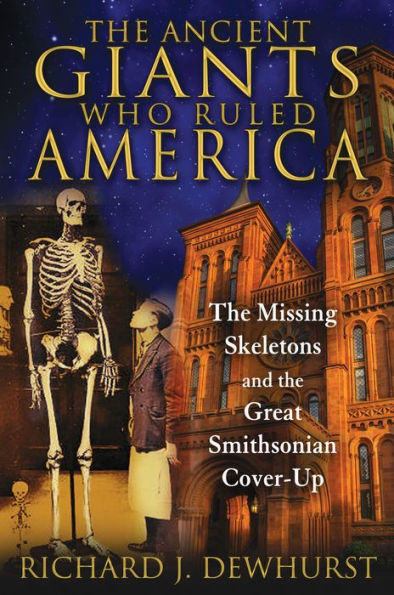Read an Excerpt
Chapter 4
Copper-Crowned Kings and Pearl-Bedecked Queens
CHARLESTON WEST VIRGINIA—HOME TO GIANTS, ANCIENT KINGS, AND HIGH PRIESTS
In many respects the West Virginia mounds are key to understanding the giants who once ruled America. Not only are the West Virginia mound sites in Charleston, Wheeling, and Moundsville some of the most significant in size and number in United States, but in 1883, the Smithsonian dispatched a team of archaeologists to conduct an extensive dig of the fifty mounds they found there and issue a detailed report.
The team was led by Professors Norris and Thomas, who prepared a detailed report of the work done by scientists who were trained in the excavating of prehistoric monuments, capable of making careful observations, and qualified to write accurate reports. The report shows quite clearly that the team uncovered numerous giants, one of which was 7'6" tall and decorated with heavy copper bracelets. In another mound, they found a circle of ten skeletons surrounding another giant skeleton, as well as underground vaults, various copper and mica ornaments, religious items, pipes and spearheads.
That the ancient giants were considered to be kings and rulers is evidenced by the numerous giant burials where the skeletons have been buried in copper crowns and other regalia such as pearl robes and mica ornaments. In this case, the crowned giants were found buried in a standing position, one of a number of unusual burial positions found in mound builder burial sites.
That the Smithsonian was at the forefront of excavations in West Virginia can be seen clearly from a Charleston Daily Mail feature story, September 23, 1923, which quotes from the Smithsonian’s own report.
FIFTY MAJOR MOUNDS IN THE CHARLESTON AREA
CHARLESTON DAILY MAIL, SEPTEMBER 23, 1923
Extending along the terrace about five miles over-looking the Kenawha River west of Charleston, above flood level were found about 50 mounds. They range in height from 5 to 35 feet. The principal one is known as the South Charleston Mound, which is 175 feet in diameter at the base and 35 feet high.
In all it is estimated that there are at least 100,000 mounds in the Eastern portion of the United States. These represent the work of millions of people, many nations and tribes, and they were constructed over a long period of time.
FIRST PERSON ACCOUNT OF THE 1883 OPENING OF THE SOUTH CHARLESTON MOUND
BY CHARLES CONNOR
CHARLESTON DAILY MAIL, APRIL 7, 1952
In looking at the history of the South Charleston Mound, it turns out our best source is A. R. Sines, grandfather of Dr. F. A. Sines, Charleston dentist. Mr. Sines, who died in 1937, had a written account of his part in the mound opening published in the 1920s.
“No doubt among the thousands of people who daily pass the large mound at South Charleston,” wrote Sines, “many have often wondered if there is anyone living who can tell what is lying, or once lay, at the bottom of that pile of earth. I am probably the only man now living who stood at the bottom of this mound and assisted with a thorough examination of every foot of its interior from top to bottom in November of 1883.”
EMPLOYED BY THE SMITHSONIAN IN 1883
Mr. Sines related that he was employed to help in the excavation by Col. P.W. Morris, an old Indian scout who was then in the employ of the Smithsonian Institution of Washington. Colonel Morris, former superintendant of the Yellowstone National Park, was investigating all mounds of West Virginia, Ohio, and nearby states at that time. In opening the mound, the men under Col. Morris’ supervision first leveled off the top, then dug a round hole ten feet in diameter downward. As they progressed towards the bottom, they dug out a series of shelves around the sides to have a place to throw the dirt.
“Four feet from the bottom we made our first discovery,” writes Sines. “We came upon a large bed of charred wood, something resembling charred bones, and many small pieces which were more intact resembling burnt teeth. This had, beyond a doubt, once been a funeral pyre.”
6 FEET 8¾ INCHES
The decayed bones belonged to what once had been a most powerful man. There was but little left, but the distance from the spot where the heel bone was found to what was left of the skull was 6 feet 8¾ inches.
The shoulder bones were considerably broader than those of men of our present race, although the skull bone was not so large. The teeth were larger than those we have today. The front part of the skull was nearly double the thickness of a human skull today.
A COPPER CROWN
Sines and Colonel Morris found a copper band around the forehead of this buried giant, and similar copper bands around the wrists and ankles. With no copper nearer than Tennessee, they assumed it had been carried here by these Mound Builders thousands of years ago.
GROOVED STONES HARDER THAN STEEL
They also found axe-shaped stones grooved in the middle. Sines related that this stone was not familiar to this country and so hard that steel would not make a dent.
“Two miles down near where Sunset Memorial Park is today,” Sines relates, “they opened a smaller mound and located the bones of what appeared to be the remnants of a woman. There were copper bands on the ankle and wrist bones and larger pieces of copper on each breast.”



